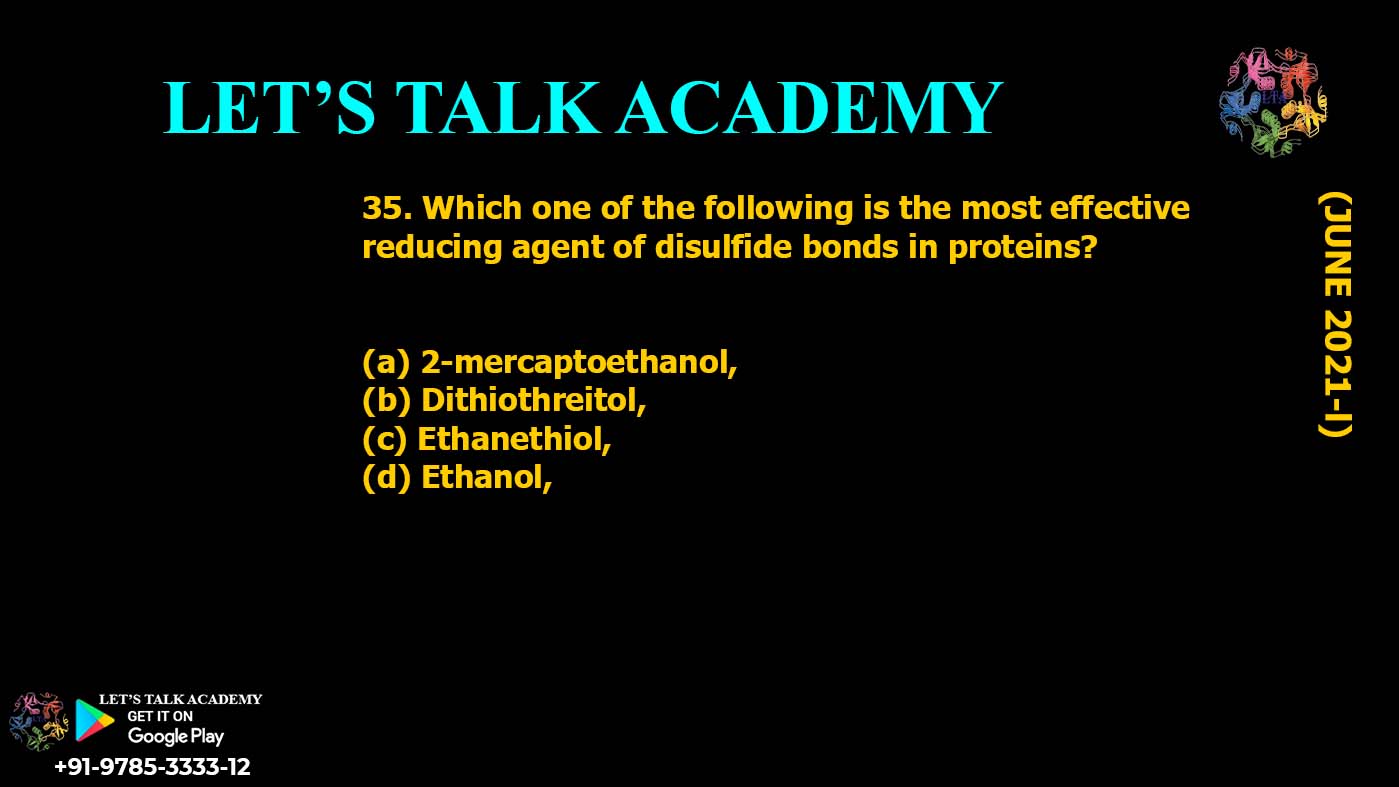35. Which one of the following is the most effective reducing agent of disulfide bonds in proteins?
(a) 2-mercaptoethanol,
(b) Dithiothreitol,
(c) Ethanethiol,
(d) Ethanol
Introduction
Disulfide bonds are critical for stabilizing the three-dimensional structure of proteins. These covalent bonds form between the sulfur atoms of cysteine residues and are essential for maintaining protein shape and function. In protein research and purification, it is often necessary to reduce or break these disulfide bonds to denature proteins or to study their folding.
Various reducing agents are used in laboratories to break disulfide bonds in proteins, but some are more effective than others. In this article, we will explore which reducing agent is most efficient at breaking disulfide bonds, and why certain agents are preferred over others.
Understanding Disulfide Bonds
A disulfide bond, also known as a sulfur-sulfur bond, is a covalent linkage between the sulfur atoms of two cysteine residues within a protein. These bonds help stabilize the protein’s tertiary structure and are commonly found in extracellular proteins, where the environment is oxidative. Breaking these bonds often involves the addition of a reducing agent, which donates electrons to the sulfur atoms, leading to the cleavage of the bond.
Common Reducing Agents Used in Protein Chemistry
There are several common reducing agents used to break disulfide bonds, each with varying effectiveness. Let’s take a look at the most commonly used reducing agents:
1. 2-Mercaptoethanol
2-Mercaptoethanol (often referred to as beta-mercaptoethanol) is one of the most commonly used reducing agents in protein chemistry. It has a thiol group (-SH) that reacts with disulfide bonds, breaking them and restoring the cysteine residues to their reduced form. Its effectiveness is due to the presence of the thiol group, which is able to donate electrons and reduce the sulfur-sulfur bond.
2. Dithiothreitol (DTT)
Dithiothreitol (DTT) is a highly effective reducing agent that also contains a thiol group. It is commonly used in biochemical experiments to reduce disulfide bonds in proteins. DTT is preferred in many situations because it is more stable in solution than 2-mercaptoethanol, especially in the presence of air. Additionally, DTT is particularly effective in reducing disulfide bonds in proteins because it provides a strong electron-donating capability.
3. Ethanethiol
Ethanethiol, also known as ethyl mercaptan, is a thiol-containing compound, but it is less commonly used than 2-mercaptoethanol and DTT. It is less effective as a reducing agent compared to 2-mercaptoethanol and DTT, due to its lower reactivity and weaker electron-donating properties.
4. Ethanol
Ethanol is not a reducing agent and does not break disulfide bonds. It is commonly used in protein research as a solvent or precipitant, but it has no effect on disulfide bonds.
Which Reducing Agent is Most Effective?
Among the commonly used reducing agents, Dithiothreitol (DTT) is considered to be the most effective at reducing disulfide bonds in proteins. Its effectiveness is attributed to its strong ability to donate electrons, as well as its stability in solution compared to other reducing agents like 2-mercaptoethanol. DTT is widely preferred for its higher efficiency and reliability in breaking disulfide bonds, especially in more complex protein systems.
Conclusion
In the context of breaking disulfide bonds in proteins, Dithiothreitol (DTT) is the most effective reducing agent, followed closely by 2-mercaptoethanol. These two agents are widely used in protein chemistry due to their strong electron-donating capabilities, which enable them to efficiently reduce disulfide bonds and unfold proteins. While ethanol and ethanethiol are not effective reducing agents for disulfide bonds, DTT and 2-mercaptoethanol remain the go-to choices for this purpose.
Answer:
The correct answer is:
(b) Dithiothreitol.




4 Comments
Vikram
April 22, 2025☘️
Akshay mahawar
April 23, 2025Done 👍
Pallavi gautam
April 23, 2025✅✅✅
yogesh sharma
May 8, 2025Done sir ji